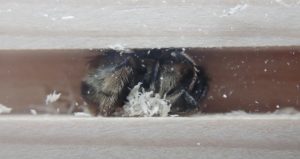Fork-tailed flower bee (Anthrophora furcata)
Although I have had the hairy-footed flower bee (Anthrophora plumipes) in my garden feeding upon lungwort,(Pulmonaria) I have not seen the fork-tailed flower bee here at all. It’s obvious when you see the hairy-footed flower bee as to why it got its name, particularly on the middle legs of the males but how the fork-tailed bee got its name is not so obvious to me.
Pollen carrying
Anthrophora species do not carry pollen on a scopa. Instead, being members of the family Apidae, (as are bumblebees and honey bees) these solitary bees carry pollen on hairs on their back legs. They lack the pollen baskets (corbicula) of a honey or bumble bee (a bare area surrounded by incurved hairs for toting pollen). Instead, like most bees, Anthophora females have a pair of scopae (a brush of hairs) on their rear legs for hauling pollen. If you think “scopal brush” you will remember it. You can clearly see this in the film.

Fork-tailed flower bee (Anthrophora furcata) chewing away inside a Nurturing Nature nest box
Nest sites
Unlike many other species of Anthrophora which nest in the ground, this species nests in pre-existing cavities and according to BWARS, it likes to nest inside burrows excavated in rotten wood, trees, fence posts and driftwood on the coast. In the film of one female rested inside the emergence chamber and did explore several cavities. The other female is inside a cavity in a different nest box in a different garden, you can clearly see her chewing her way along the floor backwards inside a pre-existing wood cavity. The sawdust is fresh and very loose, though not particularly fine at this stage. Else and Edwards (2018) state the females seek out nesting burrows in deadwood. The cells are made as an oval-shaped enlargement of the chosen burrow. She uses fine compacted sawdust or wood she has chewed from the burrow she is excavating inside to make the cell walls. Provided the wood is rotten enough, these bees can initiate and then enlarge a cavity to nest inside.
Looking at the film, it appears to me that she is enlarging the cavity and I suspect she may then chew the shaving up into finer wood dust for her walls if she was to nest there. But alas she didn’t, so I won’t know for sure! In both cases, the bees themselves did not nest in the nest box though they did explore nesting cavities inside it. Perhaps the wood was not rotten enough at that time! The chewing behaviour I have seen before with the woodcarving leafcutter bee, (Megachile ligniseca) which have nested in my nest boxes several times now, a film of which is to follow soon. Falk mentions that some nest cells for this genus are lined with a waterproof substance. I expect that if the rotten wood is already damp or if it is very dry then it would hold moisture so this makes a lot of sense, also bearing in mind many of them nest in the ground, use cliffs or walls.
Refs and further reading:
Else and Edwards (2018) “Handbook of the Bees of the British Isles”, The Ray Society, c/o The Natural History Museum, Cromwell Road London SW7 5BD
Steven Falk’s Field Guide to the Bees of Great Britain and Ireland is a must-have book if you want to ID bees and this extremely useful resource Steven Falk’s Flickr website which furnishes extra photos and other useful resources to assist with identification.
Solitary Bees by Ted Benton I highly recommend
Nice blog here with photos by TrogTrogBlog
Handy Anthrophora furcata information sheet by Africa Gomez/BWARS
With special thanks to Pauline Smith and Charlotte Rankin both of whom ID’d the bees and provided the films

Recent Comments